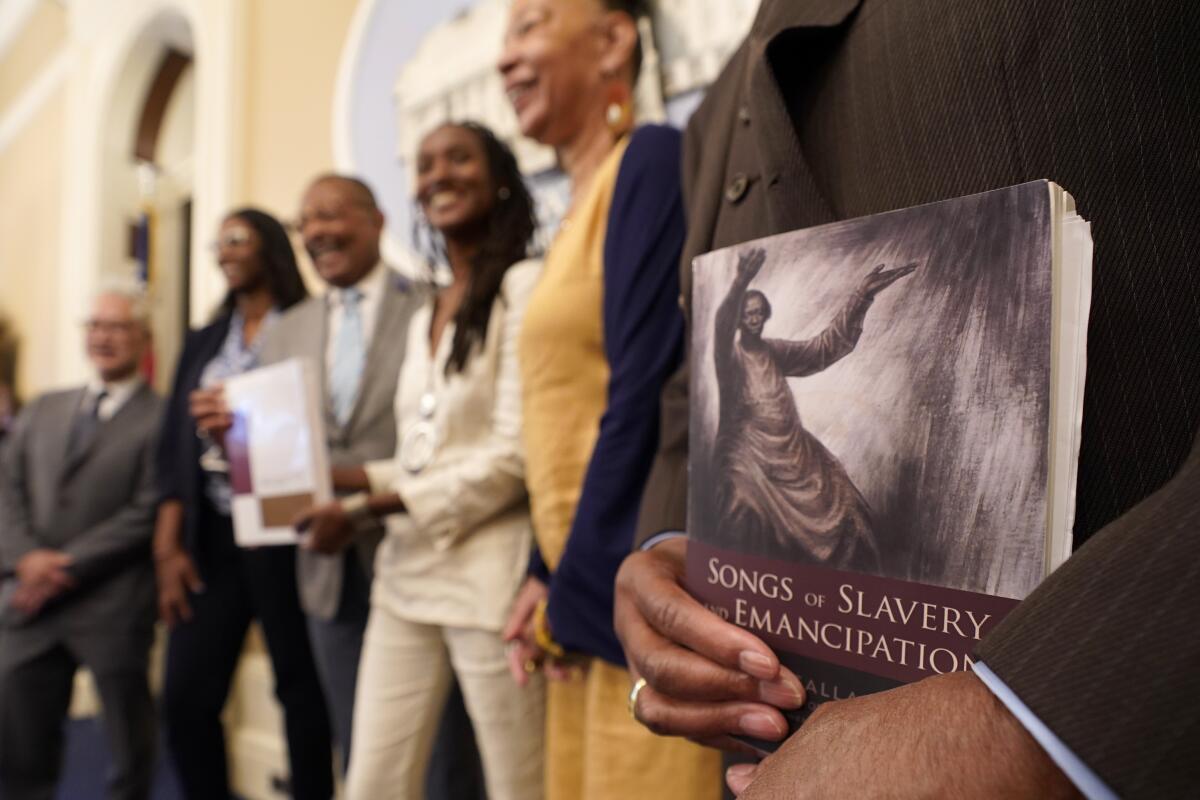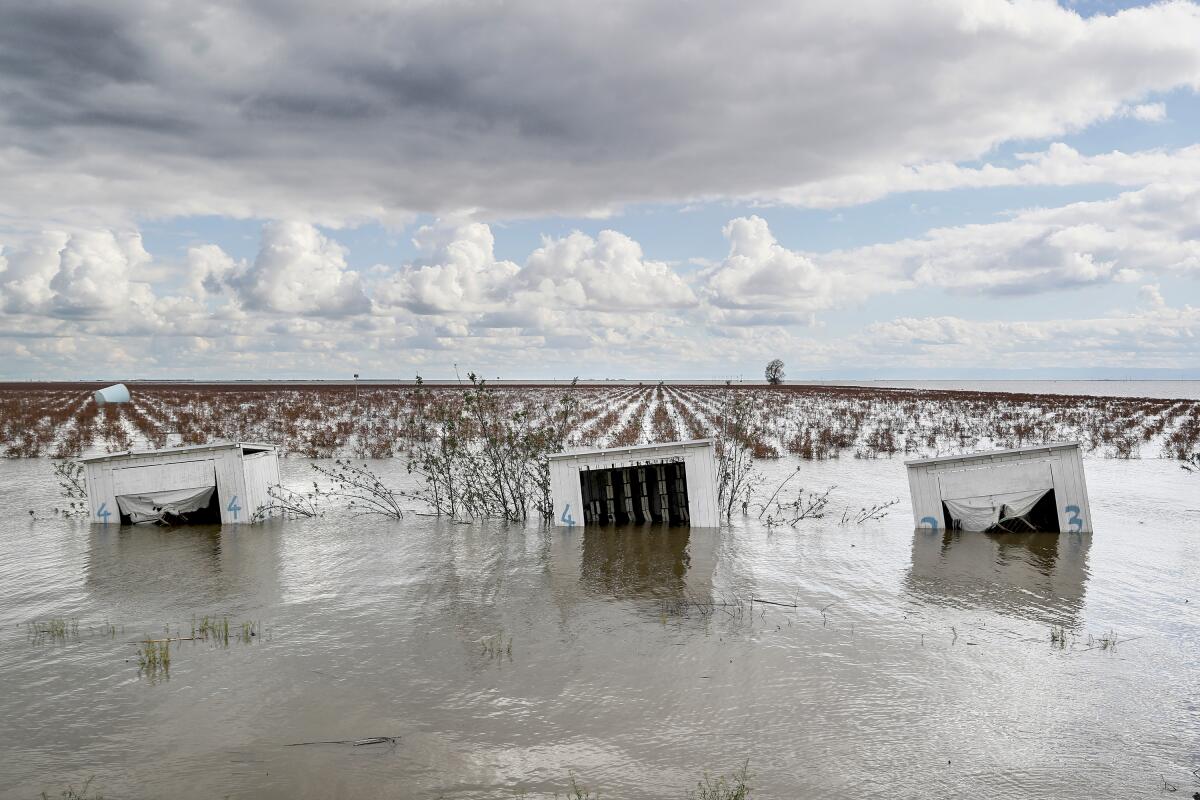Reparations and affirmative action: California confronts new questions on race

Good morning, and welcome to the Essential California newsletter. It’s Friday, June 30. I’m Erika D. Smith and I’m a columnist for The Times reporting from Sacramento.
For the past two years, I’ve had the privilege of covering California’s reparations task force — the nine-member body charged with researching and recommending how Gov. Gavin Newsom and the Legislature should go about compensating Black people for the lasting harms of slavery and racism.
I call it a “privilege” because, in following the task force’s meetings, I’ve learned more about my history as a Black woman than I ever did in school. I now have a much clearer understanding of who my ancestors were, and what they endured before and after being enslaved in Mississippi, Alabama and, most likely, Louisiana.
But this isn’t just my history or Black history. This is American history. And so, on Thursday, the task force released its final report to the public — its last official act and its last official meeting.
A behemoth that rivals the girth of an Oxford dictionary when printed and bound, the report lays out in unassailable detail the many ways California’s government has disrupted the advancement of Black people, from our attempts to build generational wealth to our efforts to get housing, a quality education and even freedom. You can read it here.
“We experienced savage inequality!” task force member Pastor Amos Brown preached in a speech that prompted an auditorium full of Black people, many of whom had traveled hundreds of miles to Sacramento for the meeting, to leap to their feet in applause.
But hooting and hollering and shouts of “I’m Black and I’m proud” aside, it was lost on no one that the task force released its final report on the same day the U.S. Supreme Court struck down affirmative action policies at colleges and universities.
In a pair of decisions, the six conservative justices — including Clarence Thomas, who benefited from affirmative action at Yale Law School — ruled that Harvard University and University of North Carolina at Chapel Hill were illegally discriminating based on race and violating the 14th Amendment of the U.S. Constitution.
“We all heard this morning about the Supreme Court,” a rueful California Secretary of State Shirley Weber told a group of reporters. It was legislation she sponsored as a member of the Assembly that led to the task force’s creation. “We fought that battle here in California many, many times. And I still have a firm belief in affirmative action.”
Indeed, it was Weber who led the last charge to get voters to overturn Proposition 209, which prohibits public universities in California for considering race and gender in public education, hiring and contracting. Voters didn’t go for it — again.
Perhaps because of this experience, Weber has long maintained that reparations must be about harm, not about race. So while the task force’s work is often discussed as benefiting “Black people,” it’s really about helping people whose ancestors were enslaved.
This decision to prioritize some Black people over other Black people based on their lineage was a big point of contention during almost every task force meeting. Not every member agreed it was fair because that’s not how racism works. Indeed, I also have my reservations.
But legally, it’s the only way reparations can work — as reinforced by the Supreme Court’s ruling on Thursday.
As Weber put it: “At some point, African Americans have to get an opportunity, they must get justice. And so this,” she said of the task force’s final report, “talks about the harm that’s done and the responsibility to repair it. When you have done harm, you have a responsibility to correct it. And to make sure it never happens again.”
Whether the lawmakers and the governor agree is another matter. Over the next few months, bills will be drafted based on the recommendations in the task force’s final report. Already, the idea of reparations isn’t politically popular, so it will be an uphill battle.
Sen. Steven Bradford (D-Gardena), one of only two lawmakers on the task force, warned as much on Thursday.
“I’m not delusional at all in thinking that this is going to be some slam dunk and that folks are gonna come on board and accept it widely,” he told The Times. “I think even many of our allies are going to have problems with some of the recommendations.”
More on the reparations task force:
- You can read my latest column here: The craziest reparations idea you won’t find in the California task force’s report.
- California’s reparations proposal moves to Newsom and state lawmakers.
- The question of reparations raises skepticism and hope among Black L.A. residents.
- From December: Kamilah Moore, task force chair, speaks with Ryan Fonseca about the group’s work.
And now, here’s what’s happening across California from Essential California editor Laura Blasey:
Note: Some of the sites we link to may limit the number of stories you can access without subscribing.
L.A. STORIES
Homelessness continues to soar, jumping 9% in L.A. County and 10% in the city, according to the annual point-in-time count released Thursday by the Los Angeles Homeless Services Authority. Efforts to house people, which include hundreds of millions of dollars spent on shelter, permanent housing and outreach, have failed to stem the growth of street encampments. Los Angeles Times
UCLA confirms it was hit by wide-ranging cyberattack but offers few details. It’s not clear what information was accessed or whether any information was posted online, though officials learned about a breach in the system that the university uses to transfer files on May 28. Los Angeles Times
Unionized hotel workers reach a deal with their biggest employer on the eve of the July 4th weekend and planned strike. The Westin Bonaventure Hotel & Suites in downtown announced it reached a tentative deal for higher pay and other benefits Wednesday evening with the union representing its employees, though it’s the first among many that will be needed to avert the planned strike. Los Angeles Times
POLITICS AND GOVERNMENT
New California laws go into effect July 1. Among them: a law that makes it easier to sue firearm retailers and sets a standard of conduct for the industry, plus a new law that will allow many people to seal their criminal records if they meet certain conditions. Sacramento Bee
Tensions are growing between some residents of Redding, Calif., and a megachurch that has grown to count 11,000 congregants in a city of just over 90,000. The leader of Bethel Church claims to perform miracles, among other controversial beliefs. But critics say they’re most concerned with the church’s growing influence in local politics, business, education and other facets of life in Redding. SFGATE
CRIME, COURTS AND POLICING
It’s been 27 years since Cal Poly San Luis Obispo student Kristin Smart disappeared. And though Paul Flores was convicted in October of murdering her, a key question remains unanswered: Where is her body? Three men are on a quest to find her using an experimental technology known as soil vapor sampling. Los Angeles Times
Support our journalism
HEALTH AND THE ENVIRONMENT

After months of concern that snowmelt would send torrents of water into an already flooded Tulare Lake and inundate more communities, Gov. Gavin Newsom’s office has announced that the waters of the resurgent lake have finally begun to recede. Los Angeles Times
If you have to buy bottled water, is there a best option? There are plenty of brands on the market, from boxed to bottled to canned to bagged — yes, bagged. But when it comes to taste, a few really do reign supreme, The Times’ Lucas Kwan Peterson writes. Los Angeles Times
CALIFORNIA CULTURE
It’s been a big year for Tom Cruise and an even bigger one for his look-alike. Evan Ferrante, an actor and producer, calls himself the “leading Tom Cruise impressionist in the world.” And business is booming, jump started by new films in the “Top Gun” and “Mission Impossible” franchises. Inverse
“There’s never been a better time to eat bagels,” declares Bon Appetit – especially outside of New York. “Regional” bagel culture is where it’s at now and California is a major player. In 2021, the New York Times argued that the best bagels are in California. Now, Bon Appetit has put seven California establishments on their best-of national list. Eat it and weep, New York! Bon Appetit
Free online games
Get our free daily crossword puzzle, sudoku, word search and arcade games in our new game center at latimes.com/games.
AND FINALLY
Today’s California landmark is from Stephen Blakesley of La Jolla, Calif., who nominates California’s rocky coastline.

Stephen writes:
Our California rock-strewn coastline beaches are iconic, and environmentally threatened. These sea lions hauled out at low tide to bask in the California sunshine in La Jolla Cove.
What are California’s essential landmarks? Fill out this form to send us your photos of a special spot in California — natural or human-made. Tell us why it’s interesting and what makes it a symbol of life in the Golden State. Please be sure to include only photos taken directly by you. Your submission could be featured in a future edition of the newsletter.
Please let us know what we can do to make this newsletter more useful to you. Send comments to [email protected].
Sign up for Essential California
The most important California stories and recommendations in your inbox every morning.
You may occasionally receive promotional content from the Los Angeles Times.




